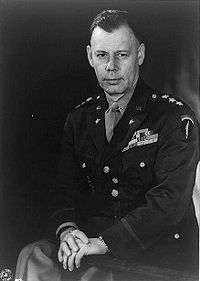Walter Bedell Smith Ambassador
Walter Bedell "Beetle" Smith (5 October 1895 – 9 August 1961) was a senior U.S. Army general who served as General Dwight D. Eisenhower's chief-of-staff at Allied Forces Headquarters during the Tunisia Campaign and the Allied invasion of Italy in 1943. Beginning in the next year, he was General Eisenhower's chief-of-staff at the Supreme Headquarters Allied Expeditionary Force (SHAEF) in Western Europe from 1944 through 1945.Smith enlisted as a private in the Indiana National Guard in 1911. In 1917, during World War I, he was commissioned as an officer. He was wounded in the Aisne-Marne Offensive in 1918. After World War I, he was a staff officer and instructor at the U.S. Army Infantry School. In 1941, he became Secretary of the General Staff, and in 1942 he became the Secretary to the Combined Chiefs of Staff. His duties involved taking part in discussions of war plans at the highest level, and Smith often briefed President Franklin D. Roosevelt on strategic matters.Smith became chief of staff to Eisenhower at Allied Forces Headquarters (AFHQ) in September 1942. He acquired a reputation as Eisenhower's "hatchet man" for his brusque and demanding manner. However, he was also capable of representing Eisenhower in sensitive missions requiring diplomatic skill. Smith was involved in negotiating the armistice between Italy and Allied armed forces, which he signed on behalf of Eisenhower. In 1944, he became the Chief of Staff of SHAEF, again under Eisenhower. In this position, Smith also negotiated successfully for food and fuel aid to be sent through German lines for the cold and starving Dutch civilian population, and opened discussions for the peaceful and complete German capitulation to the Canadian Army in the Netherlands. In May 1945, Smith met representatives of the German High Command in Reims, France, to conduct the surrender of the German Armed Forces, and he signed the German Instrument of Surrender on behalf of General Eisenhower.After World War II, he served as the U.S. Ambassador to the Soviet Union from 1946 to 1948. Then in 1950, Smith became the Director of Central Intelligence, the head of the Central Intelligence Agency (CIA) and other intelligence agencies in the United States. Smith reorganized the CIA, redefined its structure and its mission, and he gave it a new sense of purpose. He made the CIA the arm of government primarily responsible for covert operations. He left the CIA in 1953 to become an Under Secretary of State. After retiring from the State Department in 1954, Smith continued to serve the Eisenhower Administration in various posts for several years, until his retirement and his death in 1961.
Search
Ambassador
| From | 1946 |
|---|---|
| To | 1948 |
| Country | |
| Awards | |
| Military operations | |
| President | |
| Successor |
Topical connections
Walter Bedell Smith on Wikipedia
External resources
- http://hdl.handle.net/2097/4219
- http://www.army.mil/cmh-pg/books/Last_Salute/Ch20.htm
- http://www.globalsecurity.org/military/library/report/other/us-army_germany_1944-46_index.htm
- http://www.history.army.mil/books/wwii/11-4
- http://www.history.army.mil/books/wwii/csppp/index.htm
- http://www.jstor.org/stable/1988341
- https://www.cia.gov/library/center-for-the-study-of-intelligence/kent-csi/vol5no4/html/v05i4a08p_0001.htm
